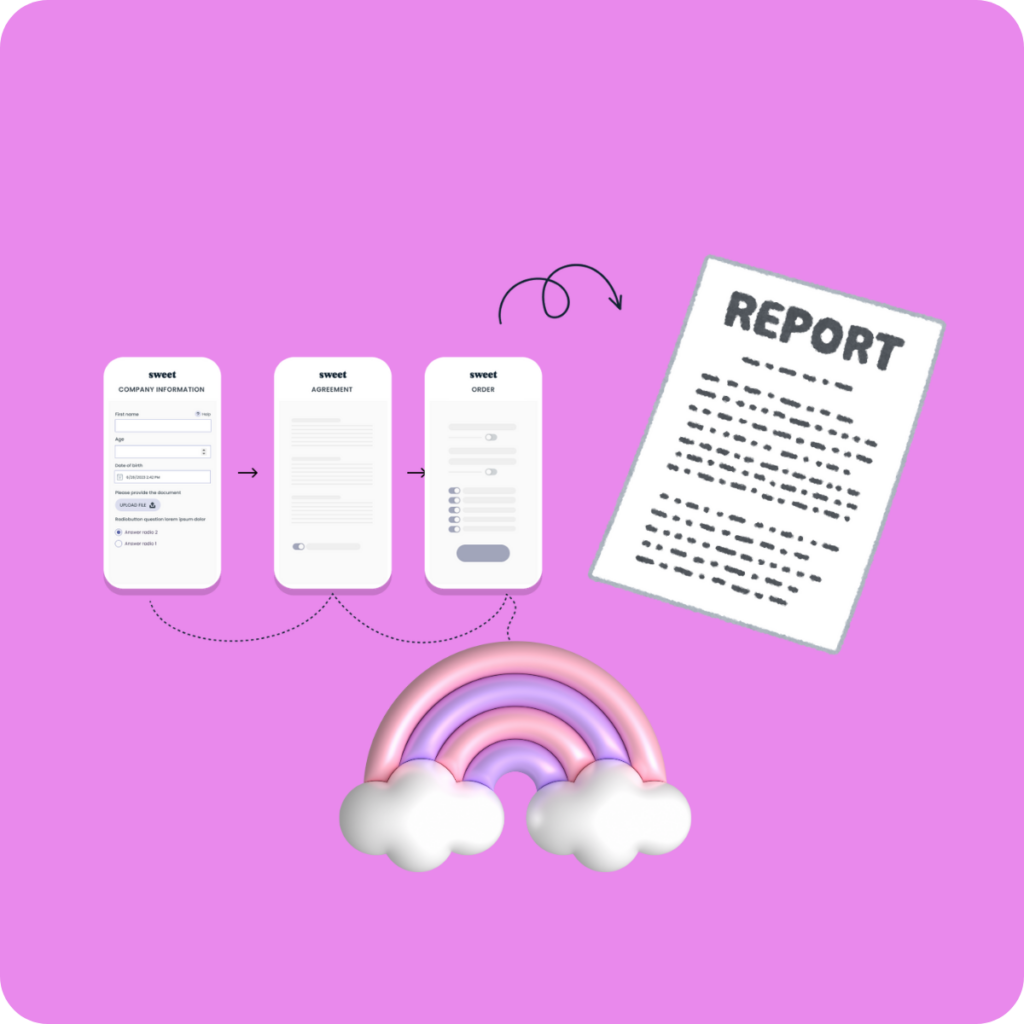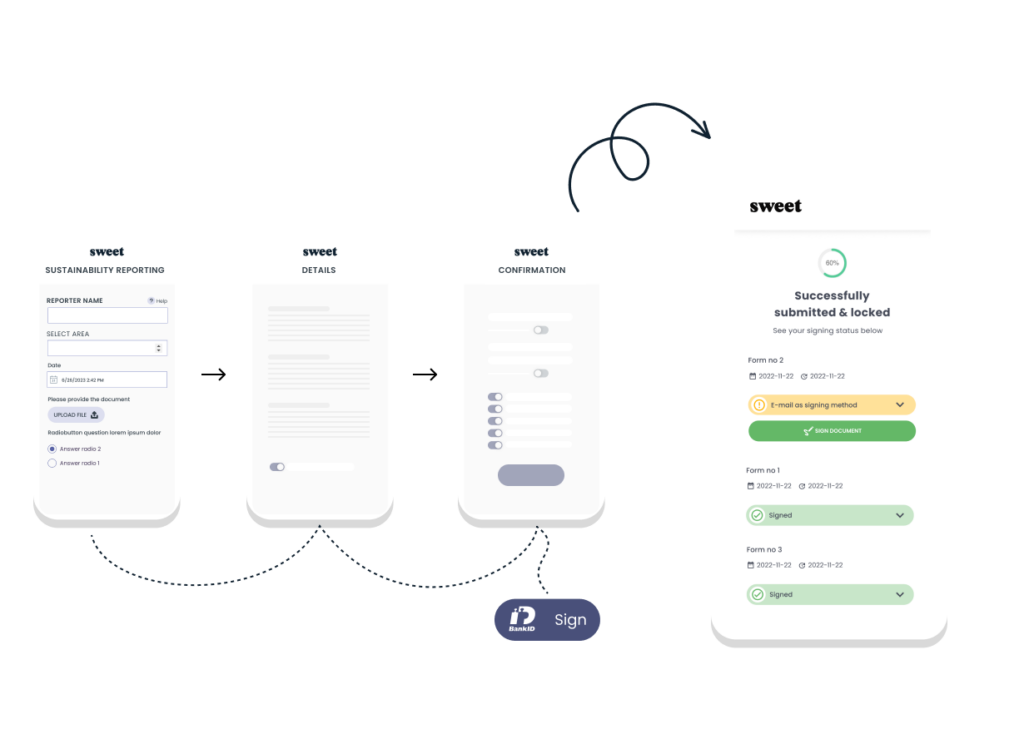Sustainability reporting is a process in which organizations report on their environmental, social, and economic impacts and performance from a sustainability perspective. This type of reporting is an important part of corporate responsibility and transparency towards stakeholders such as investors, customers, employees, and society at large. At the governmental level, there is now a proposal that more companies and organizations should be subject to the requirement for sustainability reporting to create better decision-making frameworks for sustainable investments¹. Here are some key aspects of sustainability reporting and how you can manage sustainability reporting with digital forms through Sweet Forms.
Purpose and benefits of sustainability reporting
- Transparency and accountability: Sustainability reporting enables companies to demonstrate how they manage sustainability-related risks and opportunities, contributing to increased trust and credibility. It also makes it easier to compare companies that follow the same standards from a competitive standpoint.
- Improved decision-making: By analyzing sustainability data, companies can better understand their impact and identify areas for improvement. It also provides a picture of the organization’s sustainability efforts that can support potential investments.
- Regulation and compliance: Many countries and regions require companies to report on their sustainability performance, making sustainability reporting a legal obligation for some. With the latest government proposal on sustainability reporting, more entities are expected to be included, and this expansion is likely to become part of Swedish law¹.

Sustainability reporting in Sweden: Background and regulations
In Sweden, sustainability reporting has been covered by EU legislation on sustainability reporting, which was introduced for certain large companies in 2016. This has now taken on a new dimension with the government’s proposal that more, including smaller companies, should be subject to the requirements for sustainability reporting. The new regulations are proposed to take effect on July 1, 2024, more details can be found on the Swedish Government Offices’ website.¹
The background and primary purpose of sustainability reporting is to provide financial markets with reliable and comparable information about companies’ sustainability efforts related to the environment, social responsibility, and corporate governance. The core idea is that more investments should be directed towards sustainable companies, promoting the management of financial risks arising from climate change and social issues.¹
Standards and frameworks for sustainability reporting
There are several standards and frameworks used for sustainability reporting, including:
- CSRD (Corporate Sustainability Reporting Directive): An EU directive on sustainability reporting based on the framework of the European Sustainability Reporting Standards ESRS.
- GRI (Global Reporting Initiative): One of the most widely used global standards, providing guidelines for reporting on a variety of sustainability topics.
- SASB (Sustainability Accounting Standards Board): Provides industry-specific standards to help companies identify and report on the sustainability factors most relevant to their operations.
- TCFD (Task Force on Climate-related Financial Disclosures): Offers recommendations for reporting on climate-related financial risks and opportunities.
For more frameworks and standards, read more on FAR’s website.²
Efficient sustainability reporting with Sweet Forms
How to conduct sustainability reporting and which solution to use?
Sweet Forms offers a digital solution that can significantly simplify sustainability reporting for your organization. Here’s how it can help:
1. Efficient data collection
Automation and standardization: Sweet Forms’ digital forms can automate the collection of sustainability data from various parts of your organization, reducing the need for manual work and minimizing the risk of errors. Standardized forms ensure that data is collected consistently across the organization.
2. Secure data storage
Security: Sweet Forms uses modern solutions to protect sensitive sustainability information from unauthorized access and data breaches. Encryption and regular security updates are examples of how security is maintained.
3. Structured data management
Data management: Information collected via Sweet Forms can be stored in structured databases or directly within the application, making it easier to analyze and report. Structured data can be quickly retrieved and processed to generate reports and insights.
4. Integration with other systems
API and data exchange: Sweet Forms can be integrated with other systems, such as financial, HR, and ERP systems, via API. This enables automated data exchange and real-time updates, improving data quality and ensuring up-to-date information.
5. Real-time reporting and analysis
Dashboards and visualizations: Responses from Sweet Forms can be presented in real-time through dashboards and other visualization tools. This makes it easier for management to monitor sustainability performance and make data-driven decisions.
6. Scalability and flexibility
Customization: Sweet Forms can easily be scaled up or down based on your organization’s needs and can be customized to collect specific sustainability information relevant to different sectors and operations.
7. Improved compliance and reporting
Traceability and auditing: Sweet Forms makes it easier to track and audit data collection processes, aiding compliance with legal requirements and external standards such as GRI, TCFD, or CSRD. This also simplifies audits and inspections by providing easily accessible and verifiable information.
By leveraging Sweet Forms, your organization can streamline its sustainability reporting, ensuring that data is collected, managed, and reported efficiently and securely.
Practical example with Sweet Forms
magine a large manufacturing company that needs to report its energy consumption, water usage, and greenhouse gas emissions. By implementing Sweet Forms’ digital solution, the company can:
- Data collection: Automatically or manually collect data from various production facilities via IoT sensors or input forms. This allows for accurate and timely data collection from all parts of the organization.
- Accurate calculations: Ensure that algorithms for calculating environmental impact are accurate. Sweet Forms can integrate with existing calculation models or use custom algorithms to process the data correctly.
- Centralized data storage: Store this information in a central database accessible to all relevant departments. This centralization makes it easy to manage and share data across the organization.
- System integration: Integrate with existing systems to gain a comprehensive view of the company’s performance. By connecting Sweet Forms with ERP, CRM, or other management systems, the company can consolidate its data for a holistic overview.
- Continuous monitoring: Use dashboards to continuously monitor sustainability performance and identify areas for improvement. Real-time visualizations allow for quick responses to any deviations or opportunities.
- Automated reporting: Generate automated sustainability reports that meet GRI standards and are directly sent to regulatory authorities and stakeholders. This not only saves time but also ensures that reports are consistent, accurate, and compliant with the required standards.

How to get started with Sweet Forms?
A well-designed digital form solution like Sweet Forms, combined with an integration and process engine, can streamline and enhance the entire sustainability reporting process—from data collection and storage to reporting and analysis—ultimately contributing to a more sustainable and transparent organization.
By using Sweet Forms’ digital solution, your organization can elevate its sustainability reporting to the next level. Contact us to learn more and see how we can help you optimize your sustainability reporting.
Källor
-
FAR. "Ramverk för hållbarhetsrapportering." FAR förklarar hållbarhet.
-
Regeringskansliet. "Nya regler om hållbarhetsrapportering." Lagrådsremiss, publicerad 16 februari 2024.

